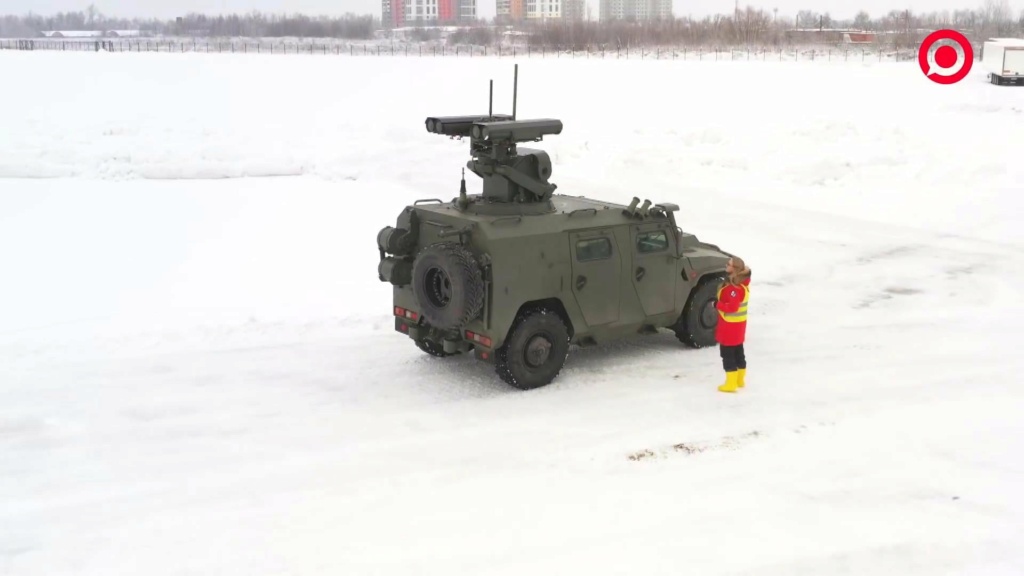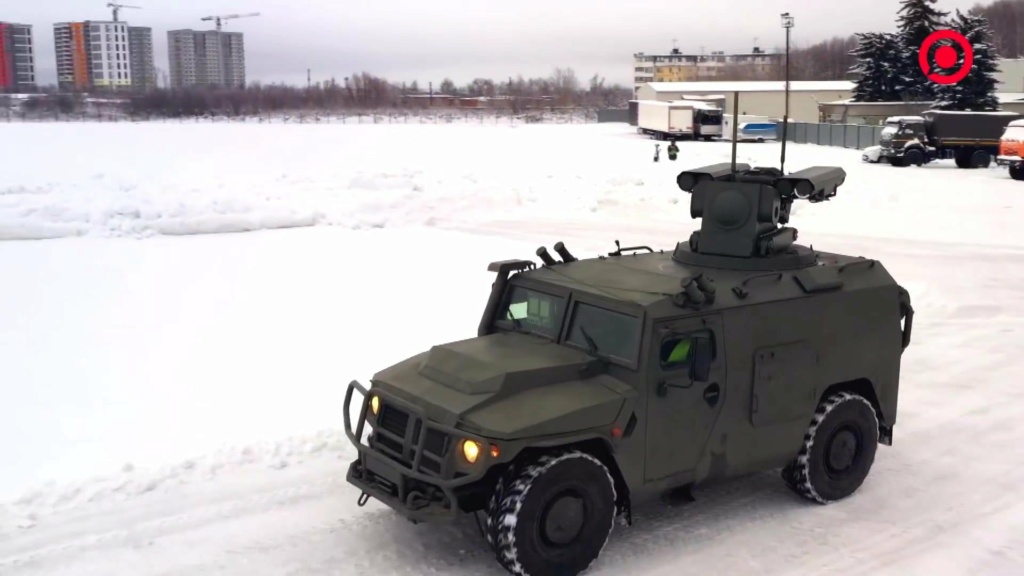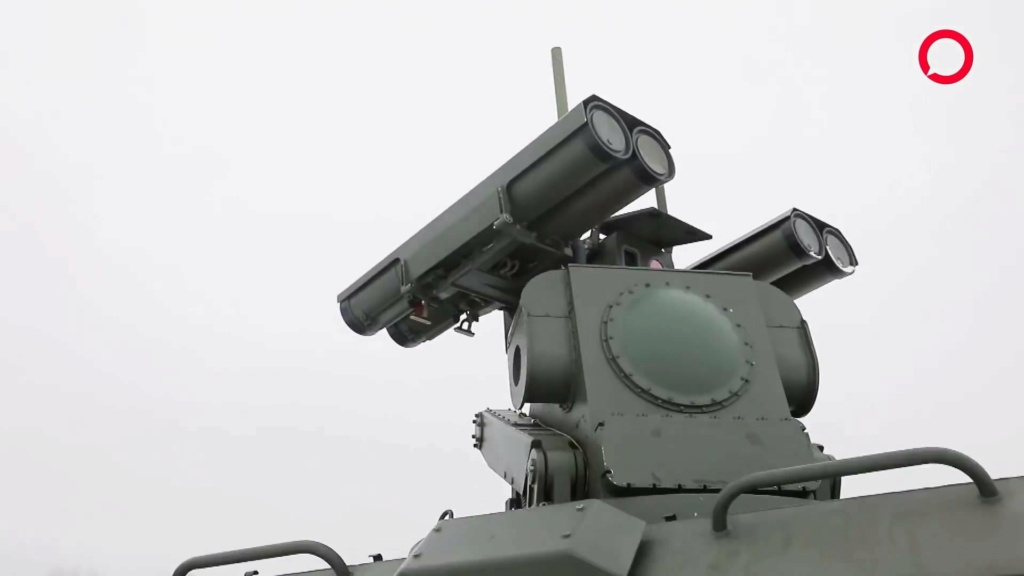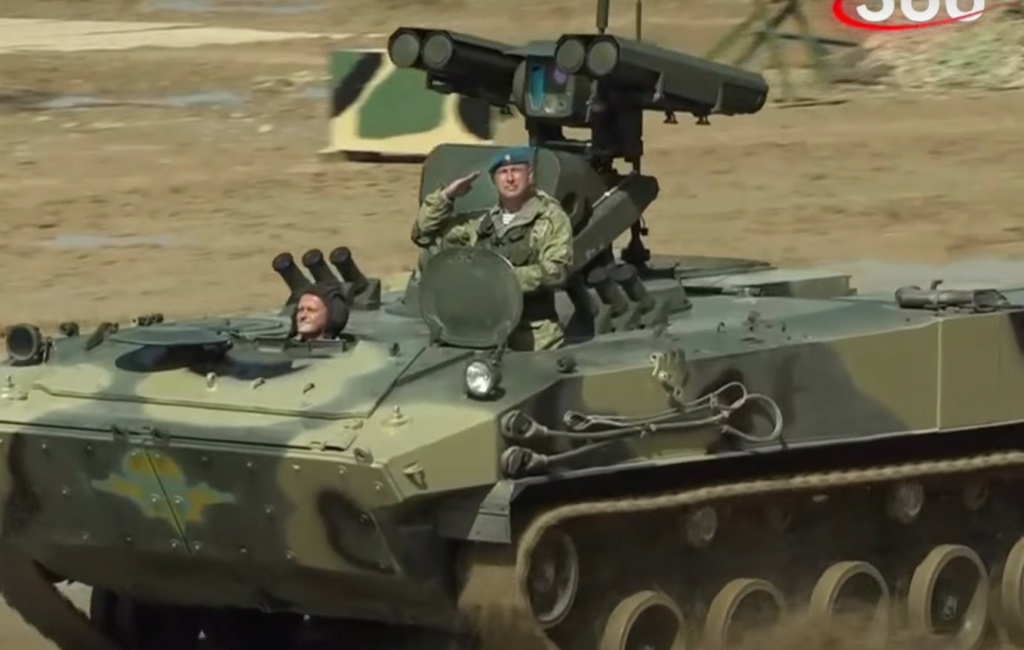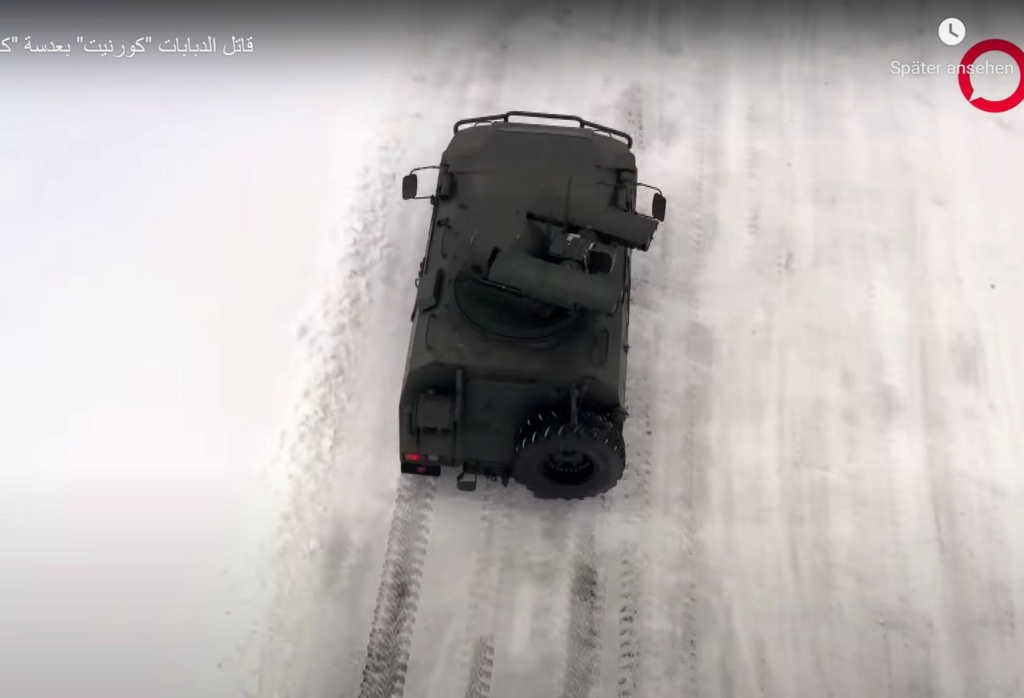Russian Army ATGM Thread

Hole- Posts : 11121
Points : 11099
Join date : 2018-03-24
Age : 48
Location : Scholzistan
- Post n°651
 Re: Russian Army ATGM Thread
Re: Russian Army ATGM Thread
GarryB, franco and George1 like this post

d_taddei2- Posts : 3028
Points : 3202
Join date : 2013-05-11
Location : Scotland Alba
- Post n°652
 Re: Russian Army ATGM Thread
Re: Russian Army ATGM Thread
1st round hit probability
AT-3A sagger A - 70-80%
AT-3C sagger C - 90%
AT-4 spigot - 90%
i found this quite interesting as there is numerous articles on the net stating how terrible these weapons accuracy is. However further in the document it stated that these systems are cheap and therefore allows foreign forces to practice more live fire training than western systems. it even stated that the saggers missiles cost was currently the cheapest system in service, from the basic missiles starting around $300-400, and rising up to of $800 for sagger D. this was in 1998. But its probably why it remains still popular today because of the cost, i cant think of any western system of the same age that still has as many countries using it. And the more modern versions such as tandem warhead, thermobaric variants, and the Serbian radio command version (5km range) will of course cost more but i cant imagine we would be looking anymore than $2000-3000 for the radio command version, and sagger D, thermobaric, tandem warhead most likely $1000-2000 a missile. I think this would still make it the cheapest ATGW system in the world. not sure how much the AT-4 or AT-5 costs these days. Although a last i read back in 1992 export price of Konkurs missile was $10,000- 13,000 and the control unit was $135,000. I do know that the LAW 94 cost £8,000, this was a disposable anti tank weapon that had spotting rifle attached to it and i found it horrible to fire (the spotting rifle), i never got the chance to fire it live as during training our company was only given 4 live ones to fire and with around 80 troops meant you had to be lucky. They actually made the live firers wear a gas mask (s-10) (only during training) to help with the dust kick up and gases it produced as well as the over pressure which the guys who fired it said it was like someone was sucking the air around you and caused the gas mask to suck against the face, so i would hate to think during an actual war what effect it would have on the firer.
GarryB, Big_Gazza and Mir like this post

Big_Gazza- Posts : 4896
Points : 4886
Join date : 2014-08-25
Location : Melbourne, Australia
- Post n°653
 Re: Russian Army ATGM Thread
Re: Russian Army ATGM Thread
d_taddei2 wrote:going through some old army documents that i found upon having a clear out. These documents i used while serving in the British army. the key point i wanted to highlight was the information on 1st round hit probability on AT-3 Sagger and AT-4 spigot. This was based on regular professional enemy troops ATGW weapon teams. (not reserve forces, terrorists, or guerilla forces).
1st round hit probability
AT-3A sagger A - 70-80%
AT-3C sagger C - 90%
AT-4 spigot - 90%
i found this quite interesting as there is numerous articles on the net stating how terrible these weapons accuracy is. However further in the document it stated that these systems are cheap and therefore allows foreign forces to practice more live fire training than western systems. it even stated that the saggers missiles cost was currently the cheapest system in service, from the basic missiles starting around $300-400, and rising up to of $800 for sagger D. this was in 1998. But its probably why it remains still popular today because of the cost, i cant think of any western system of the same age that still has as many countries using it. And the more modern versions such as tandem warhead, thermobaric variants, and the Serbian radio command version (5km range) will of course cost more but i cant imagine we would be looking anymore than $2000-3000 for the radio command version, and sagger D, thermobaric, tandem warhead most likely $1000-2000 a missile. I think this would still make it the cheapest ATGW system in the world. not sure how much the AT-4 or AT-5 costs these days. Although a last i read back in 1992 export price of Konkurs missile was $10,000- 13,000 and the control unit was $135,000. I do know that the LAW 94 cost £8,000, this was a disposable anti tank weapon that had spotting rifle attached to it and i found it horrible to fire (the spotting rifle), i never got the chance to fire it live as during training our company was only given 4 live ones to fire and with around 80 troops meant you had to be lucky. They actually made the live firers wear a gas mask (s-10) (only during training) to help with the dust kick up and gases it produced as well as the over pressure which the guys who fired it said it was like someone was sucking the air around you and caused the gas mask to suck against the face, so i would hate to think during an actual war what effect it would have on the firer.
People seem to forget that while an older ATGM like the AT-3 can't kill an Abrams MBT, it can easily take out soft-skinned vehicles like cars, trucks and oil tankers, as well as light armoured vehicles like APCs and IFVs. They are also useful against general hard targets like buildings and simple fortifications. Just because a weapon isn't effective against a battleground top alpha predators, doesn't mean it lacks significant value as a general weapon.

GarryB, d_taddei2, JohninMK, Hole and Mir like this post

GarryB- Posts : 40541
Points : 41041
Join date : 2010-03-30
Location : New Zealand
- Post n°654
 Re: Russian Army ATGM Thread
Re: Russian Army ATGM Thread
The early model Saggers were manually controlled which means when sitting comfortably and not being fired at most of the time the missile could be steered accurately... there was a gap of about 500m in the first few seconds of flight where you couldn't hit the side of a barn... which is why the BMP-1 has a 73mm gun to kill tanks and vehicles inside about 800m to fill that gap.
CLOS or command to line of sight missiles are easy to use and very accurate... except one American missile called Dragon... which is the awful weapon the Javelin replaced. The Dragon III was a 1km range missile that had a very stupid propulsion system.
The propulsion systems for missiles is tricky because if it was like a sky rocket that burned from the back forward then the centre of gravity of the weapon would shift as it flew and burned fuel, so most missiles have the fuel in the centre and a warhead at the back and the front.... the rocket motor of the RPG-7 has its exhaust nozzles just behind the warhead just in front of the tube it is inserted into to fire.
Anyway the Dragon III had small solid rocket thruster motors... about 60 of them and they were wrapped around the middle of the missile. After being blown from the launch tube the missile had a slow roll in flight so as the rockets rolled around they were all in pairs so the bottom pair would fire and they were angled backwards to generate lift and forward thrust and then the next pair would roll to the bottom and they would fire giving it another push and onwards and onwards.
It made the design simple but any flight corrections needed to get the missile back on target would result in rockets in different positions firing too which would also give forward thrust but might turn the missile left or right or cause it to climb or descend.
As you can imagine if you were not steady with the sight and wobbled around all over the place then lots of the side rockets would be used up correcting the flight and you might run out of rockets to keep it airborne and it drops into the ground... even if it is only 500m away... its range was 1km.
The Soviet equivalent at the time was the Metis which was a much much better missile, but during the cold war 1980s no mention of Metis was made... they had AT-3, AT-4, AT-5, and AT-6 on their helicopters and that was it.
d_taddei2 likes this post

d_taddei2- Posts : 3028
Points : 3202
Join date : 2013-05-11
Location : Scotland Alba
- Post n°655
 Re: Russian Army ATGM Thread
Re: Russian Army ATGM Thread
Big_Gazza wrote:d_taddei2 wrote:going through some old army documents that i found upon having a clear out. These documents i used while serving in the British army. the key point i wanted to highlight was the information on 1st round hit probability on AT-3 Sagger and AT-4 spigot. This was based on regular professional enemy troops ATGW weapon teams. (not reserve forces, terrorists, or guerilla forces).
1st round hit probability
AT-3A sagger A - 70-80%
AT-3C sagger C - 90%
AT-4 spigot - 90%
i found this quite interesting as there is numerous articles on the net stating how terrible these weapons accuracy is. However further in the document it stated that these systems are cheap and therefore allows foreign forces to practice more live fire training than western systems. it even stated that the saggers missiles cost was currently the cheapest system in service, from the basic missiles starting around $300-400, and rising up to of $800 for sagger D. this was in 1998. But its probably why it remains still popular today because of the cost, i cant think of any western system of the same age that still has as many countries using it. And the more modern versions such as tandem warhead, thermobaric variants, and the Serbian radio command version (5km range) will of course cost more but i cant imagine we would be looking anymore than $2000-3000 for the radio command version, and sagger D, thermobaric, tandem warhead most likely $1000-2000 a missile. I think this would still make it the cheapest ATGW system in the world. not sure how much the AT-4 or AT-5 costs these days. Although a last i read back in 1992 export price of Konkurs missile was $10,000- 13,000 and the control unit was $135,000. I do know that the LAW 94 cost £8,000, this was a disposable anti tank weapon that had spotting rifle attached to it and i found it horrible to fire (the spotting rifle), i never got the chance to fire it live as during training our company was only given 4 live ones to fire and with around 80 troops meant you had to be lucky. They actually made the live firers wear a gas mask (s-10) (only during training) to help with the dust kick up and gases it produced as well as the over pressure which the guys who fired it said it was like someone was sucking the air around you and caused the gas mask to suck against the face, so i would hate to think during an actual war what effect it would have on the firer.
People seem to forget that while an older ATGM like the AT-3 can't kill an Abrams MBT, it can easily take out soft-skinned vehicles like cars, trucks and oil tankers, as well as light armoured vehicles like APCs and IFVs. They are also useful against general hard targets like buildings and simple fortifications. Just because a weapon isn't effective against a battleground top alpha predators, doesn't mean it lacks significant value as a general weapon.
I agree, sagger is still deadly, and it's certainly served the Syrian army well, taking out buildings and armour, and in a long drawn out war the cost of ammo is certainly is a key factor. The SPG-9 has also seen widespread use in Syria for being cheap and good at destroying bunkers and buildings. Buildings don't move loooool. After experience in Syria gained in Syria I can see why Russia is now looking at a new light weight SPG-9 type system, although no real information on a system yet, I wonder if they will incorporate a system that includes a spg-9 system but make it lighter, more accurate, and likely a multiple types of rounds, from tandem warhead, HE-Frag, thermobaric, and a cheap missile for longer ranges a sort of ATGW that we see on BMP-3 like Bastion. The missile could be a reduced in size bastion around 80mm with a range of UpTo 3km would be enough, but the main use of the system would be using rounds similar to spg-9, taking out light armour, buildings, bunkers, and if needed use the bastion type missile for long range targets inc helicopters that come within range.

lyle6- Posts : 2588
Points : 2582
Join date : 2020-09-14
Location : Philippines
- Post n°656
 Re: Russian Army ATGM Thread
Re: Russian Army ATGM Thread
The most modern MBT - and even IFVs would be protected against most such threats. There are even heavy ERA kits that can withstand oblique flank shots from PG-29V type warheads. APS both soft-kill and hard-kill provide an even greater level of protection to include against heavy Kornet ERA, and top attack munitions. At best the single digit ATs can cause mission-kills. Not the ideal outcome if you are risking troops against MBTs with superior observation and firepower.GarryB wrote:The upgraded Malyutka-M has a penetration performance of over 800mm, so it is perfectly capable of taking out even the most modern tanks from the side...
The single digit ATs are mostly used as pocket artillery these days. Taking out mostly troop positions, soft-skinned vehicles, materiel and the like. The way they are used they are like a longer ranged and guided SPG-9 recoilless rifle - which is funny because Saab just released a guided round for their Carl Gustav. Soviet surplus > modern new-build.d_taddei2 wrote:
I agree, sagger is still deadly, and it's certainly served the Syrian army well, taking out buildings and armour, and in a long drawn out war the cost of ammo is certainly is a key factor. The SPG-9 has also seen widespread use in Syria for being cheap and good at destroying bunkers and buildings. Buildings don't move loooool. After experience in Syria gained in Syria I can see why Russia is now looking at a new light weight SPG-9 type system, although no real information on a system yet, I wonder if they will incorporate a system that includes a spg-9 system but make it lighter, more accurate, and likely a multiple types of rounds, from tandem warhead, HE-Frag, thermobaric, and a cheap missile for longer ranges a sort of ATGW that we see on BMP-3 like Bastion. The missile could be a reduced in size bastion around 80mm with a range of UpTo 3km would be enough, but the main use of the system would be using rounds similar to spg-9, taking out light armour, buildings, bunkers, and if needed use the bastion type missile for long range targets inc helicopters that come within range.

d_taddei2- Posts : 3028
Points : 3202
Join date : 2013-05-11
Location : Scotland Alba
- Post n°657
 Re: Russian Army ATGM Thread
Re: Russian Army ATGM Thread
lyle6 wrote:The most modern MBT - and even IFVs would be protected against most such threats. There are even heavy ERA kits that can withstand oblique flank shots from PG-29V type warheads. APS both soft-kill and hard-kill provide an even greater level of protection to include against heavy Kornet ERA, and top attack munitions. At best the single digit ATs can cause mission-kills. Not the ideal outcome if you are risking troops against MBTs with superior observation and firepower.GarryB wrote:The upgraded Malyutka-M has a penetration performance of over 800mm, so it is perfectly capable of taking out even the most modern tanks from the side...The single digit ATs are mostly used as pocket artillery these days. Taking out mostly troop positions, soft-skinned vehicles, materiel and the like. The way they are used they are like a longer ranged and guided SPG-9 recoilless rifle - which is funny because Saab just released a guided round for their Carl Gustav. Soviet surplus > modern new-build.d_taddei2 wrote:
I agree, sagger is still deadly, and it's certainly served the Syrian army well, taking out buildings and armour, and in a long drawn out war the cost of ammo is certainly is a key factor. The SPG-9 has also seen widespread use in Syria for being cheap and good at destroying bunkers and buildings. Buildings don't move loooool. After experience in Syria gained in Syria I can see why Russia is now looking at a new light weight SPG-9 type system, although no real information on a system yet, I wonder if they will incorporate a system that includes a spg-9 system but make it lighter, more accurate, and likely a multiple types of rounds, from tandem warhead, HE-Frag, thermobaric, and a cheap missile for longer ranges a sort of ATGW that we see on BMP-3 like Bastion. The missile could be a reduced in size bastion around 80mm with a range of UpTo 3km would be enough, but the main use of the system would be using rounds similar to spg-9, taking out light armour, buildings, bunkers, and if needed use the bastion type missile for long range targets inc helicopters that come within range.
Cheaper anti tank weapons could still prove useful against modern tanks, blowing tracks off, or overloading soft and hard kill systems working in tandem with kornet. Firing 3-4 sagger along with kornet could be useful, or a tank with just ERA the cheaper ATGW could blast away ERA making way for kornet or konkurs to deal catastrophic kill. And another aspect such as Syria or Afghanistan, the former using cheap missiles and T-55 tanks to do the brunt of the work cheap reliable and easy to maintain. While the latter the USA UK. Etc were using expensive javelin to destroy trucks, mud huts, and machine nests, not wise and not sustainable.

GarryB- Posts : 40541
Points : 41041
Join date : 2010-03-30
Location : New Zealand
- Post n°658
 Re: Russian Army ATGM Thread
Re: Russian Army ATGM Thread
I agree, sagger is still deadly, and it's certainly served the Syrian army well, taking out buildings and armour, and in a long drawn out war the cost of ammo is certainly is a key factor.
Sagger can hit a point target even if it starts to move after you fire, and the CLOS model is relatively easy to use where you simply put the crosshair on the target and keep it there.
If you have it in stores then it just makes sense to use it in a real conflict because it is a powerful weapon that uses precision so you don't need repeated shots that will warn the target what is coming... the first shot should normally do the job.
At 800mm penetration... that is better than Javelin...
Every situation where ATGMs have been taken to war they have been used against all sorts of targets... the British in the Falklands were using Milan against enemy MG positions... when the Argentinians invaded the marines on the island used 66mm LAWs to take out some of their amphibious landing armoured vehicles...
RPGs and ATGMs are handy and effective and if you use them then you deal with a threat and don't have to keep carrying them around...
The SPG-9 has also seen widespread use in Syria for being cheap and good at destroying bunkers and buildings. Buildings don't move loooool. After experience in Syria gained in Syria I can see why Russia is now looking at a new light weight SPG-9 type system, although no real information on a system yet,
For targets that don't move they are excellent... and I can think of one modification that could keep it being cheap but make it much more effective.
By putting a gyro in each unguided rocket you can stabilise and simplify its flight and trajectory making it rather more accurate... especially in cross winds and the like. Does not cost much money but normalises the flight path to make it vastly more predictable. Together with a sight mounted laser range finder and ballistic computer and these things could be extremely accurate out to very useful ranges without being expensive at all.
I wonder if they will incorporate a system that includes a spg-9 system but make it lighter, more accurate, and likely a multiple types of rounds, from tandem warhead, HE-Frag, thermobaric, and a cheap missile for longer ranges a sort of ATGW that we see on BMP-3 like Bastion. The missile could be a reduced in size bastion around 80mm with a range of UpTo 3km would be enough, but the main use of the system would be using rounds similar to spg-9, taking out light armour, buildings, bunkers, and if needed use the bastion type missile for long range targets inc helicopters that come within range.
Better rockets for SPG-9 with specific and advanced warheads would be very useful, but the guided rocket idea is a separate tangent I suspect is Bulat which seems to be a smaller calibre high speed missile with likely decent range and accuracy and low cost... I would expect it could be attached to a Kornet mount though perhaps a lighter more portable launcher could be developed and perhaps unified with the new Metis-M3 which could also be adapted to laser beam riding homing too as a cheap simple solution.
Good HE payloads for the SPG-9 would be valuable, especially a gyro stabilised rocket, that could be used against stationary objects to extended ranges.
For moving targets Bulat would make more sense, while at closer ranges RPG and RPO-M can be used...
SPG-9 should extend fire power past normal small arms fire range which makes the teams safer, but they will have a range of other weapons too like the new 40mm grenade launchers and various disposable rockets too.
The most modern MBT - and even IFVs would be protected against most such threats.
True, but having a group of ATGM troops armed with Malyutka-M with 10-15 missiles and 300 more ready to be moved to their position is rather more valuable than... this is Javelin... we only have 5 of them and one you use them they are no more....
Clever use of Malyutkas can inflict damage and use up APS munitions while keeping more potent and more capable missiles in reserve.
Equally a lot of the time especially in COIN type conflicts they are used against all sorts of targets where they will be just as effective as a much more capable but also much more expensive system saving the more expensive systems for better protected targets.
At best the single digit ATs can cause mission-kills. Not the ideal outcome if you are risking troops against MBTs with superior observation and firepower.
I think you are being too pessimistic... single digit ATs have killed Abrams tanks in combat... Konkurs is such a weapon... if used well they remain very effective systems and for all we know the enemy might develop countermeasures for APS systems anyway. ERA has joins where a hit might not result in the ERA blocks reacting properly or at all.
In a situation like US troops in Afghanistan an upgraded AT-3 produced cheaply by Serbia and sold at an eye watering profit margin to US troops they would still be much better than Javelin in that scenario... and they could have been issued with 100 times more missiles yet payed 1,000 times less for the weapons.
Would not have won them the war but it might have kept a few of them a bit safer having more accurate stand off weapons where you can reach out and touch and they can't touch you back is a good thing.
The single digit ATs are mostly used as pocket artillery these days. Taking out mostly troop positions, soft-skinned vehicles, materiel and the like.
Very true, but an SPG-9 would be excellent against targets that do not move that therefore don't require a guided weapon.
Using Javelin against such targets should be a crime against the US taxpayer.
They probably dumped all their Dragon IIIs on allies as soon as they could.
Cheaper anti tank weapons could still prove useful against modern tanks, blowing tracks off, or overloading soft and hard kill systems working in tandem with kornet.
Using up old stocks of missiles makes sense even without upgrades to their warheads... and ATGMs are used against such a wide variety of targets on a battlefield it makes sense to have a choice.
For Russia in some regions where they might be fighting the terrain will limit armour and channel armour which means ambushes are easier to effect, but even their brand new Metis variants and Bulat seem to be cost effective missiles that could be bought in large numbers while they seem to have a lot of Konkurs missiles because they tended to produce a lot of missiles... whether they were SAMs or ATGMs they expected to use a lot of them.
Firing 3-4 sagger along with kornet could be useful, or a tank with just ERA the cheaper ATGW could blast away ERA making way for kornet or konkurs to deal catastrophic kill.
I think Mindstorm mentioned that a possible use for Bulat would be to fire it first followed immediately by a Kornet so you have two supersonic missiles heading towards the target perhaps a few dozen metres between them in flight riding the same laser beam to the target... I expect that would be a challenge to most APS systems... and of course the basics... chaff to blind MMW radar APS sensors etc etc... nothing is perfect...
While the latter the USA UK. Etc were using expensive javelin to destroy trucks, mud huts, and machine nests, not wise and not sustainable.
The machine gun nests and sniper positions and light Toyota vehicles they hit with Javelin because it was outside the range of AT4 RPGs would not be able to tell the difference if it was hit instead by a Sagger.
Their main problem of course is that their legacy ATGM was DRAGON III and it was a total dog.
Russia, on the other hand have a unified launcher that can fire AT-4 and AT-5 missiles which are direct analogs to Milan and HOT respectively, but they retain Sagger missiles and the Metis missiles were intended to be very cheap too. At close range they have an enormous range of disposable and reusable weapons that can be used out to about 5-600m effectively, while SPG-9 can hit targets at about 1.5km with the HEAT round and about 4km for the HE round... which is rather interesting.
Its ammo looks just like the 73mm rounds of the BMP-1 except it uses more propellent.
One of the suggested guns for the BMP-2 was an increased pressure 85mm version with an enlarged and more powerful rocket...
Note they look like RPG-7 rounds but the RPG-7 tube is only 40mm which means the rocket propelling the weapon in flight can only be 40mm diameter, while the 73mm gun of the BMP-1 and the proposed 85mm gun for the BMP-2 as well as the 105mm calibre RPG-29 could use much more powerful full calibre rocket motors, which greatly extended their useful range.

George1- Posts : 18520
Points : 19025
Join date : 2011-12-22
Location : Greece
- Post n°659
 Re: Russian Army ATGM Thread
Re: Russian Army ATGM Thread
Russia’s new Kornet anti-tank missile system adapted for any vehicle
The Kornet-EM has a flexible structure and can be mounted on one or two masts
MOSCOW, December 1. /TASS/. The High Precision Weapons Company (part of the state tech corporation Rostec) has adapted the Kornet-EM anti-tank missile system for any chassis, Company Deputy CEO Sergey Mikhailov told TASS at the EDEX 2021 international defense show in Egypt on Wednesday.
"We can say that the Kornet-EM has become a universal anti-tank missile system: it has been adapted for any tracked or wheeled chassis with the corresponding lifting capacity. Therefore, it can fully meet the requirements for anti-tank weapons," the deputy chief executive said.
In its baseline modification, the Kornet-EM is mounted on two telescopic masts that carry four missiles each, he said.
"The Kornet-EM has a flexible structure and can be mounted on one or two masts. Actually any present-day vehicle can carry the Kornet: the weapon’s inclusion in a military unit boosts the unit’s capabilities for striking all types of targets with high accuracy," Mikhailov said.
Also, the Kornet-EM anti-tank missile system supplied in its automated launcher configuration is distinguished by high precision, he added.
The Kornet-EM anti-tank missile system is designated to strike tanks and other armored targets, including vehicles outfitted with reactive armor. The missile is directed by a laser beam. The Kornet-EM anti-tank missile system’s firing range has been extended to 8 km whereas its previous versions have an engagement range of 5.5 km.
Director of Russia’s Federal Service for Military-Technical Cooperation Dmitry Shugayev told TASS at the Army 2021 international arms show on August 23 that Russia had received several requests on the potential delivery of self-propelled Kornet-EM systems based on the Tigr armored vehicles (produced by Russia’s Military Industrial Company) to foreign customers.
https://tass.com/defense/1369003
GarryB, d_taddei2, kvs and Mir like this post

George1- Posts : 18520
Points : 19025
Join date : 2011-12-22
Location : Greece
- Post n°660
 Re: Russian Army ATGM Thread
Re: Russian Army ATGM Thread
Russia modernizes one of most powerful anti-tank missiles in the world
The 9M123M Khrizantema is adapted for the latest combat helicopters, in particular the Mil Mi-28NM and Kamov Ka-52M
MOSCOW, December 2. /TASS/. Russia’s major design, research, and production center, the Machine-Building Design Bureau (KBM, part of Rostec state corporation) is modernizing the Khrizantema missile, one of the most powerful anti-tank missiles in the world, General Designer at KBM Valery Kashin told TASS.
"The Khrizantema missile is being upgraded," he said. According to Kashin, there are currently no plans to upgrade the previous generation of anti-tank missiles - the 9M120 Ataka.
The 9M123M Khrizantema anti-tank missile is one of the most powerful Russian-made anti-tank missiles. The missile is part of the armament of the Khrizantema-S self-propelled anti-tank missile system, and is also adapted for the latest combat helicopters, in particular the Mil Mi-28NM and Kamov Ka-52M.
https://tass.com/defense/1369587
GarryB, kvs, PapaDragon, Hole and Mir like this post

Hole- Posts : 11121
Points : 11099
Join date : 2018-03-24
Age : 48
Location : Scholzistan
- Post n°661
 Re: Russian Army ATGM Thread
Re: Russian Army ATGM Thread
GarryB, medo, George1, d_taddei2, magnumcromagnon, Big_Gazza, kvs and like this post

d_taddei2- Posts : 3028
Points : 3202
Join date : 2013-05-11
Location : Scotland Alba
- Post n°662
 Re: Russian Army ATGM Thread
Re: Russian Army ATGM Thread
GarryB likes this post

GarryB- Posts : 40541
Points : 41041
Join date : 2010-03-30
Location : New Zealand
- Post n°663
 Re: Russian Army ATGM Thread
Re: Russian Army ATGM Thread
I would expect flight range is increased and flight speed is increased to increase flight range.
I suspect Ataka is will be winding down production so there is no point improving those... they are still a cheap simple missile that is effective out to about 5km against a range of still and moving targets.
They likely made enormous numbers of them, it was the primary guided weapon of the Hind series attack helicopters... taking over from the older very similar Shturm.
There are an enormous range of targets on a battlefield and often accuracy is more important than armour penetration.
Firing missiles at light trucks with HMGs on the back it wont notice if the warhead is an Ataka with 800mm or penetration or a Khrisantema with 1.2m of penetration... but one critical factor is that the Ataka can be carried 8 missiles to a pylon on an Mi-28 or new model Hind, while for most aircraft the Krisantema needs to use a pylon for a targeting pod for all weather use.
Interesting photo showing ATAKA at the top and Khrisantema below it... very capable but also very affordable missiles.

d_taddei2- Posts : 3028
Points : 3202
Join date : 2013-05-11
Location : Scotland Alba
- Post n°664
 Re: Russian Army ATGM Thread
Re: Russian Army ATGM Thread
GarryB wrote:Nice, but shame they didn't specify what they were going to improve...
I would expect flight range is increased and flight speed is increased to increase flight range.
I suspect Ataka is will be winding down production so there is no point improving those... they are still a cheap simple missile that is effective out to about 5km against a range of still and moving targets.
They likely made enormous numbers of them, it was the primary guided weapon of the Hind series attack helicopters... taking over from the older very similar Shturm.
There are an enormous range of targets on a battlefield and often accuracy is more important than armour penetration.
Firing missiles at light trucks with HMGs on the back it wont notice if the warhead is an Ataka with 800mm or penetration or a Khrisantema with 1.2m of penetration... but one critical factor is that the Ataka can be carried 8 missiles to a pylon on an Mi-28 or new model Hind, while for most aircraft the Krisantema needs to use a pylon for a targeting pod for all weather use.
Interesting photo showing ATAKA at the top and Khrisantema below it... very capable but also very affordable missiles.
I did read that the air launched version had a range of 10km, which is an improvement, but are they further improving range? It's annoying when an article says it's improving something but no details in which aspects. Am sure more info will come out in the next month or two.

GarryB- Posts : 40541
Points : 41041
Join date : 2010-03-30
Location : New Zealand
- Post n°665
 Re: Russian Army ATGM Thread
Re: Russian Army ATGM Thread
I would think firing it from 3,000m up the side of a mountain at a target on a flat open plain in front of the mountain might extend the effective range but that is assuming the range limit is missile velocity limited... maybe the command guidance system has a range limit...
But I would think it is more velocity and speed related which means for example a drone carrying an Ataka missile launch tube at 8km altitude might be able to hit target 10-15km away depending on visibility... such missiles don't have wings as such to support them in flight unpowered so their ability to hit targets at greater ranges might be limited by the fact that they would be falling guided bomb type weapons and perhaps are only effective to 7 or 8km from any altitude of launch.
There is talk of the Vikhr fired from the Hokum having an 8km range, but is range from an Su-25 being 10km... the difference being flight speed of the launch platform I presume as they both had similar Shkval-M and Shkval-K optical guidance systems for the job.
Maybe the upgrade is just to make them compatible with export Mi-28Ms.
Have seen it being used in War Thunder and many of the very experienced players don't think much of the Khrisantema because it has a similar range of about 6km to Ataka, while Vikhr allows launching at greater ranges... the effect on target is highly variable depending where it hits it...
But then the SOSNA-R is a 10km range missile from a similar sized tube that moves at almost double its speed and can be used against ground targets though I suspect it doesn't have the penetration performance the Khrisantema does (1.2m is impressive) and was shown on Combat Approved...
Perhaps more sophisticated guidance that lofts the trajectory of the missile to get a steeper angle on the target so angled armour becomes less effective and longer ranges are easier to achieve with the missile... who knows... I can understand them wanting to keep it secret.

magnumcromagnon- Posts : 8138
Points : 8273
Join date : 2013-12-05
Location : Pindos ave., Pindosville, Pindosylvania, Pindostan
- Post n°666
 Re: Russian Army ATGM Thread
Re: Russian Army ATGM Thread
GarryB likes this post

medo- Posts : 4343
Points : 4423
Join date : 2010-10-24
Location : Slovenia
- Post n°667
 Re: Russian Army ATGM Thread
Re: Russian Army ATGM Thread
GarryB, franco, flamming_python, magnumcromagnon, lyle6 and Krepost like this post

magnumcromagnon- Posts : 8138
Points : 8273
Join date : 2013-12-05
Location : Pindos ave., Pindosville, Pindosylvania, Pindostan
- Post n°668
 Re: Russian Army ATGM Thread
Re: Russian Army ATGM Thread
I see what looks like a radar panel/antennae, I wonder if they added an additional radar receiver on the back of the Kornet missile to give it command guided all weather capability? Perhaps the inclusion of the radar improves the accuracy against land, water surface, drone, helicopter and other CAS targets? Perhaps the versions of Kornet-M with 2 launchers (4 missiles each) that adds this additional radar antennae can launch a salvo of all 8 missiles in quick succession, and instead of hitting targets in a single-file fashion, perhaps they can attack with a 'wolf-pack' attack pattern?

Hole- Posts : 11121
Points : 11099
Join date : 2018-03-24
Age : 48
Location : Scholzistan
- Post n°669
 Re: Russian Army ATGM Thread
Re: Russian Army ATGM Thread
GarryB, franco and flamming_python like this post

medo- Posts : 4343
Points : 4423
Join date : 2010-10-24
Location : Slovenia
- Post n°670
 Re: Russian Army ATGM Thread
Re: Russian Army ATGM Thread
Interesting information from Tula, new Kornet missile have non contact proximity fuse, which activate warhead up to 3 m distance from target. It is made for engaging low flying targets like Helicopters and UAVs.

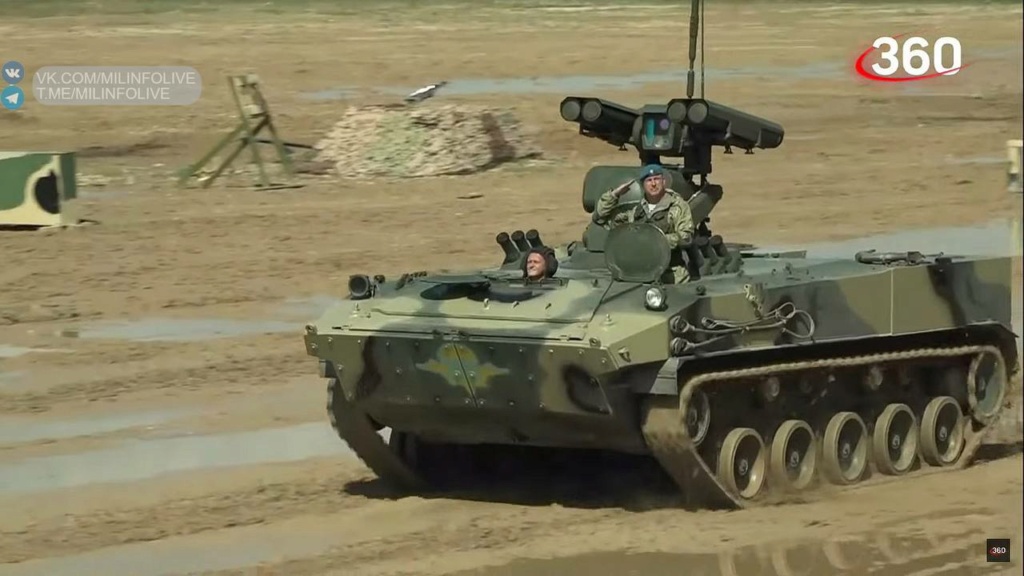
This one is interesting. We already sow it on BMD-4M vehicle. With missile capable to engage flying targets, this version have sense as kind of VSHORAD. I don't know, if new Kornet could be used in radar mode as Krisanthema missile, but circular radar antenna is a kind of tracking radar. Radar could still guide missile in automatic regime through optical sight (laser guidance). Radar is angeled to look upward and it is fixed antenna, so it could be PESA/AESA type, that it doesn't need to move on elevation. Interesting box under tracking radar could be IFF antenna. Combat module could turn around for 360o and missiles with optical sight are free to move on high angels of elevation. Missile have range of 10 km, similar to Krizanthema and Sosna. If radar is capable to search and track ground targets, than we have excellent complex against ground and aerial targets in automatic radar mode. Opticaly it could engage any target.
GarryB, George1, dino00, d_taddei2, magnumcromagnon, miketheterrible, lyle6 and like this post

Krepost- Posts : 786
Points : 788
Join date : 2021-12-08
- Post n°671
 Re: Russian Army ATGM Thread
Re: Russian Army ATGM Thread
Do you have the source or video of those new KORNET pictures?

medo- Posts : 4343
Points : 4423
Join date : 2010-10-24
Location : Slovenia
- Post n°672
 Re: Russian Army ATGM Thread
Re: Russian Army ATGM Thread
Unfortunately in Arab.
dino00, magnumcromagnon, ALAMO, Hole and Krepost like this post

ALAMO- Posts : 7503
Points : 7593
Join date : 2014-11-25
- Post n°673
 Re: Russian Army ATGM Thread
Re: Russian Army ATGM Thread
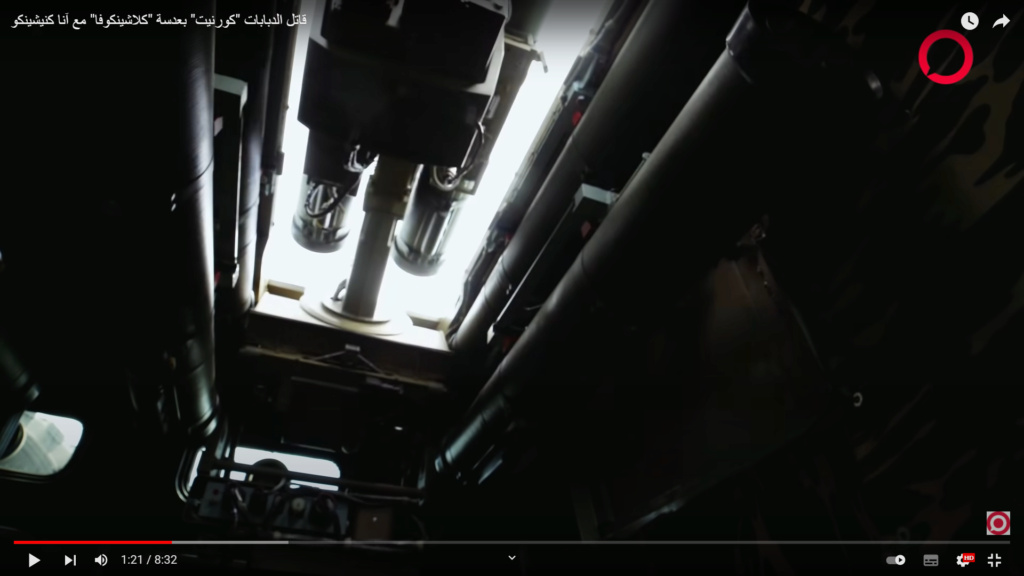
For reference, a special version of a Spike carrier for the Polish Army is Rosomak-S. It is a brand new design, only ordered in 2019.
It is called a "spikebus", because does nothing more in real - it has no turret, no other weapon on board, and carries only an AT team with - focus now - "increased Spike load" that is ... up to 8 missiles.
And it does not include the extractable Spike turrets with operators sitting inside, safe, oh no!
You need to dismount a team with a standard Spike launcher, and they will shoot from the ground.
This little Russkie badass has two independent operator panels inside the hull, can aim two targets simultaneously, and has at least double the ammo load.
This Rosomak is probably double the size&weight.
GarryB, magnumcromagnon, miketheterrible and Hole like this post

Hole- Posts : 11121
Points : 11099
Join date : 2018-03-24
Age : 48
Location : Scholzistan
- Post n°674
 Re: Russian Army ATGM Thread
Re: Russian Army ATGM Thread

d_taddei2- Posts : 3028
Points : 3202
Join date : 2013-05-11
Location : Scotland Alba
- Post n°675
 Re: Russian Army ATGM Thread
Re: Russian Army ATGM Thread
Yeah that's what I thought, I thought the design of retractable down into the vehicle was good idea not just for reloading. But disguising the vehicle as any other tigr vehicle which could be useful when in convoys, especially with drones these days picking off key vehicles. It also keeps vehicle profile low.

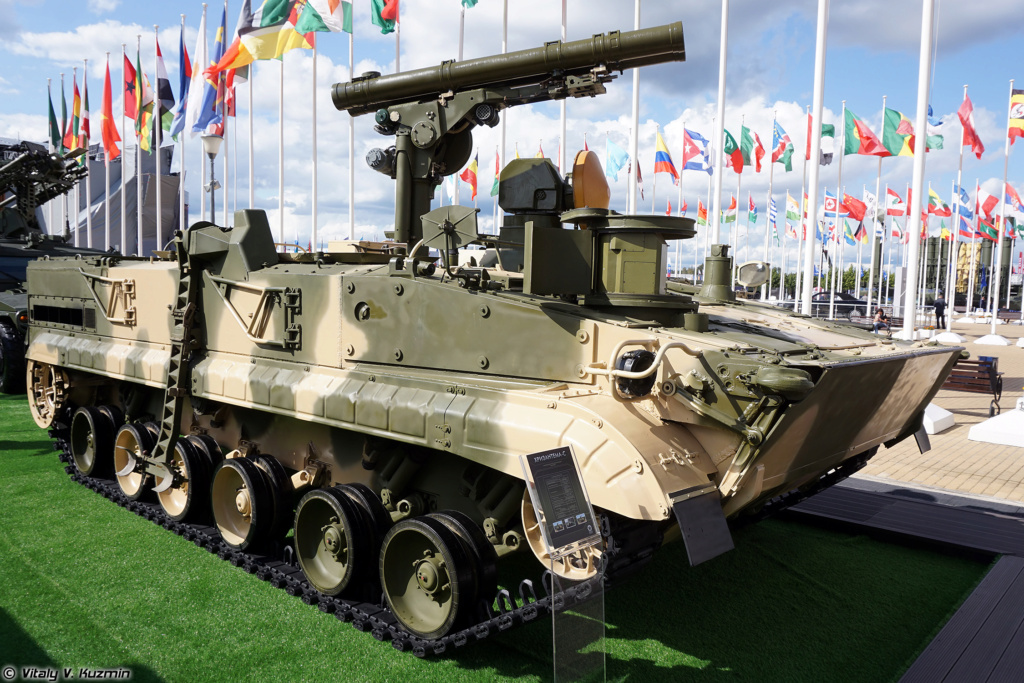

 lyle6
lyle6
